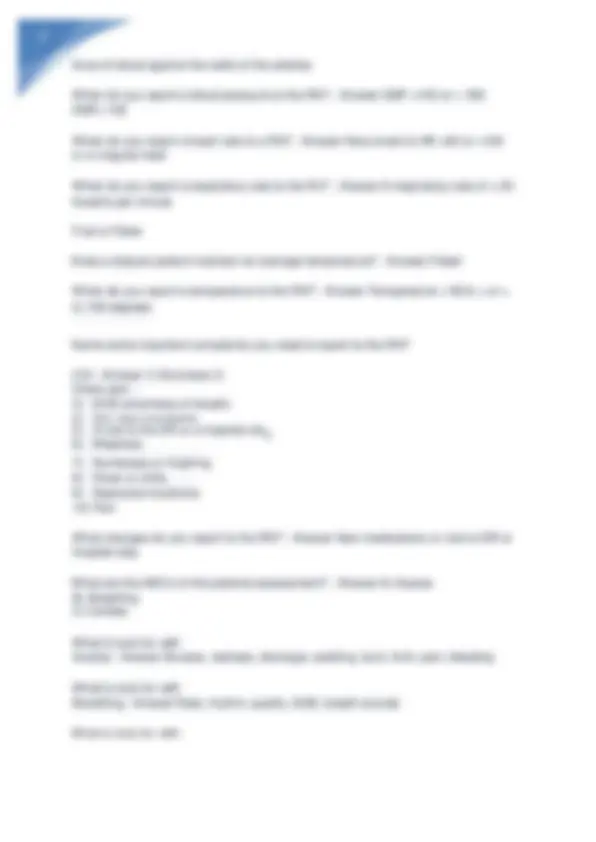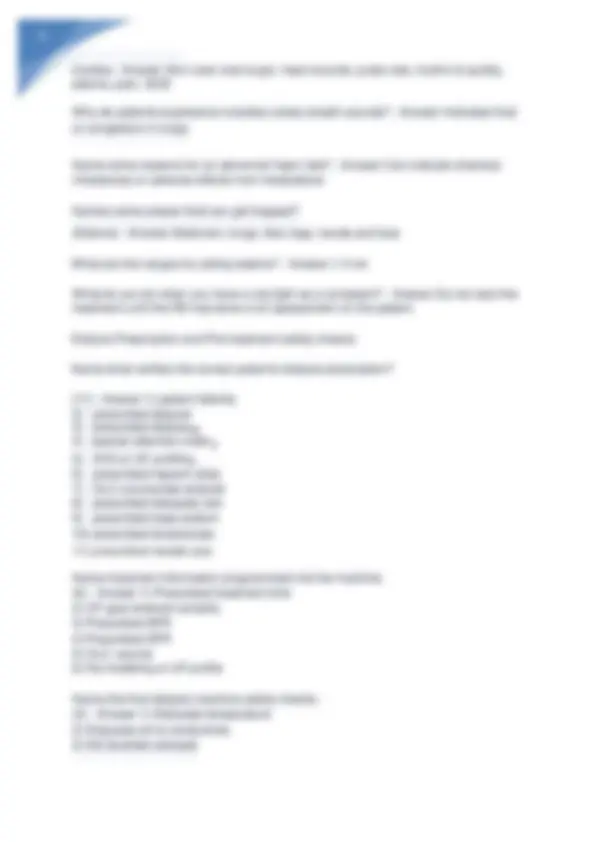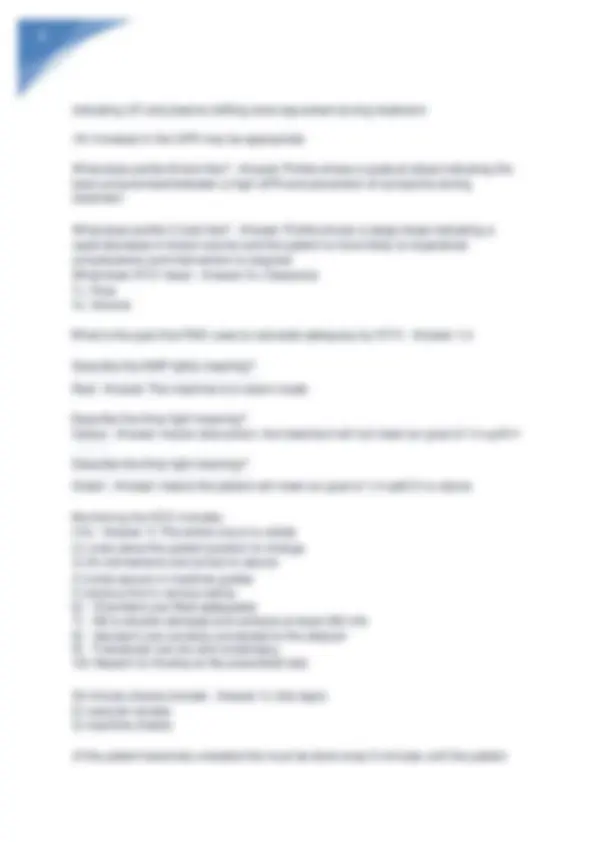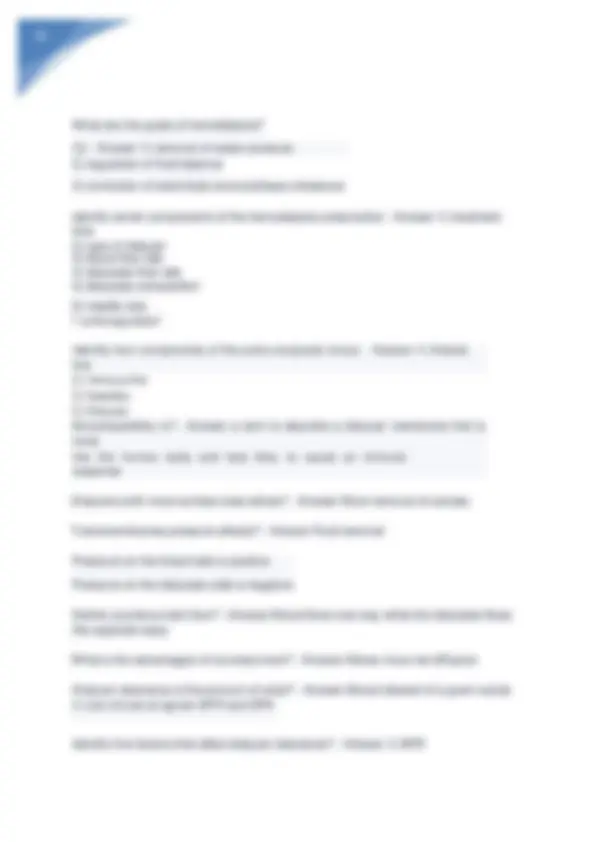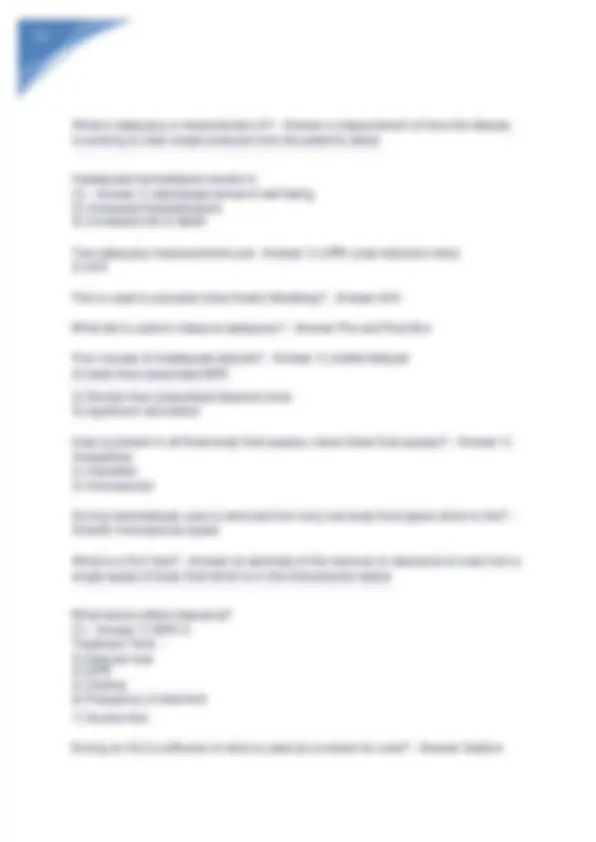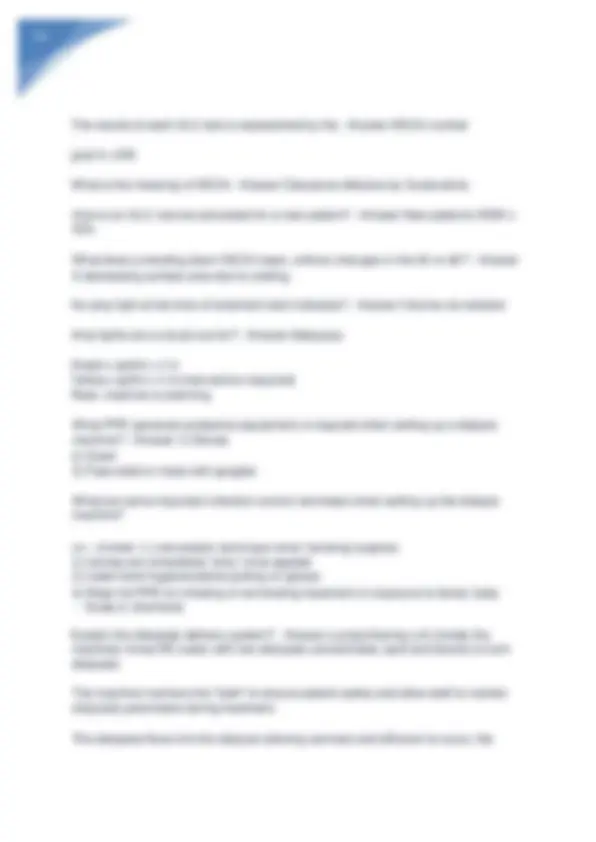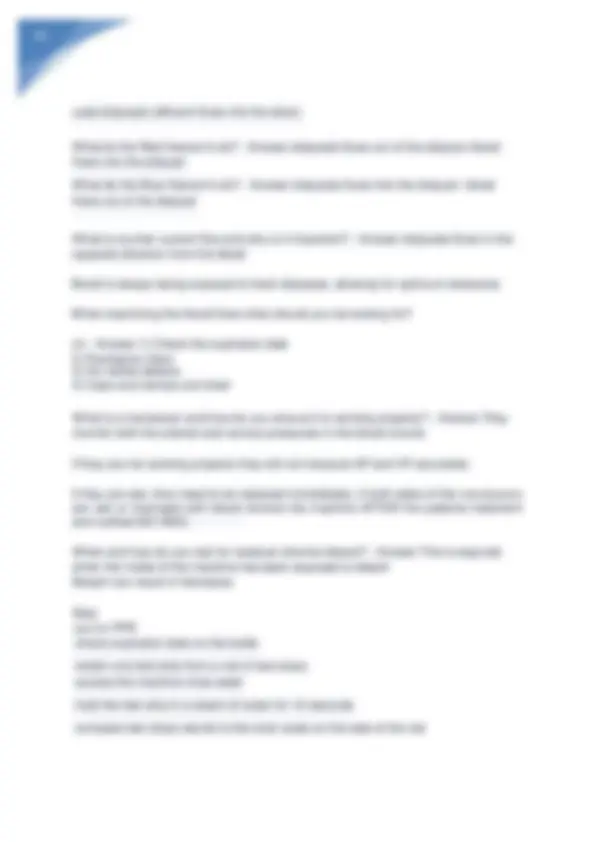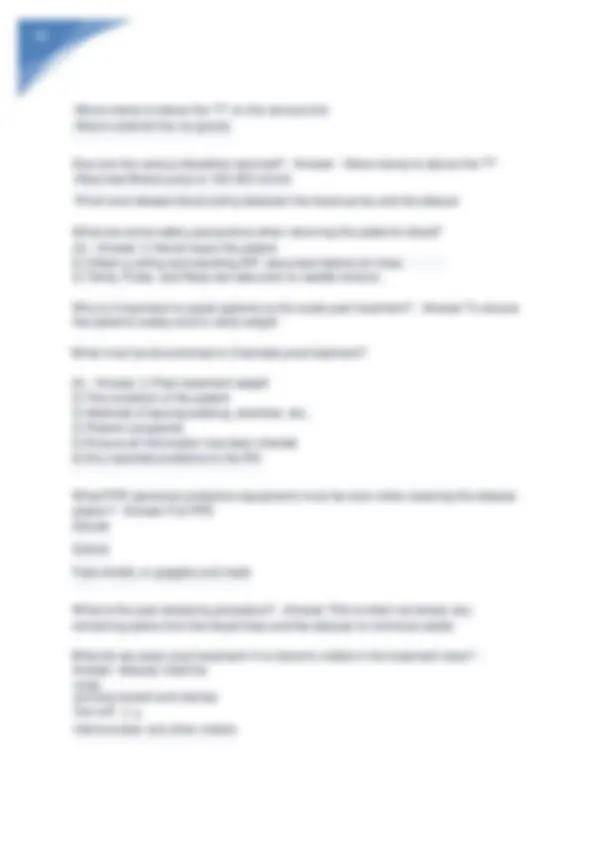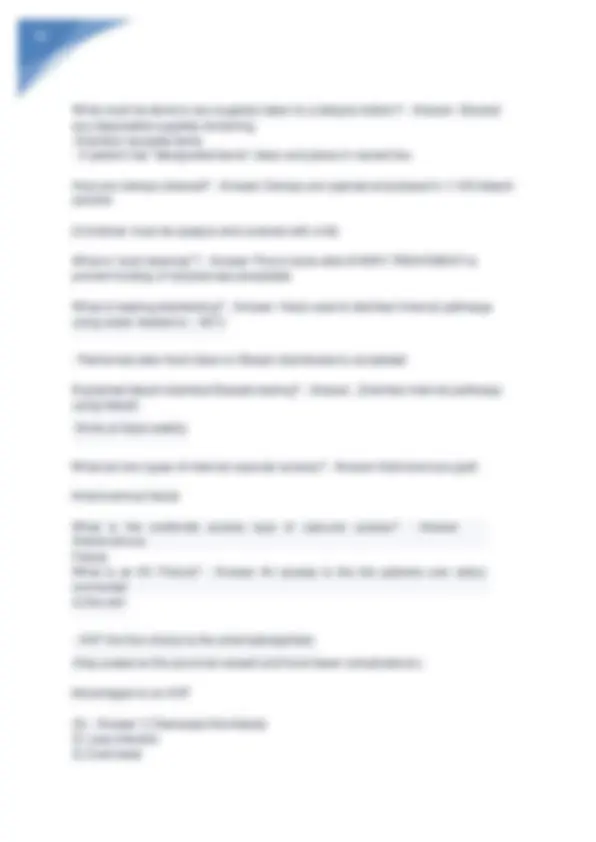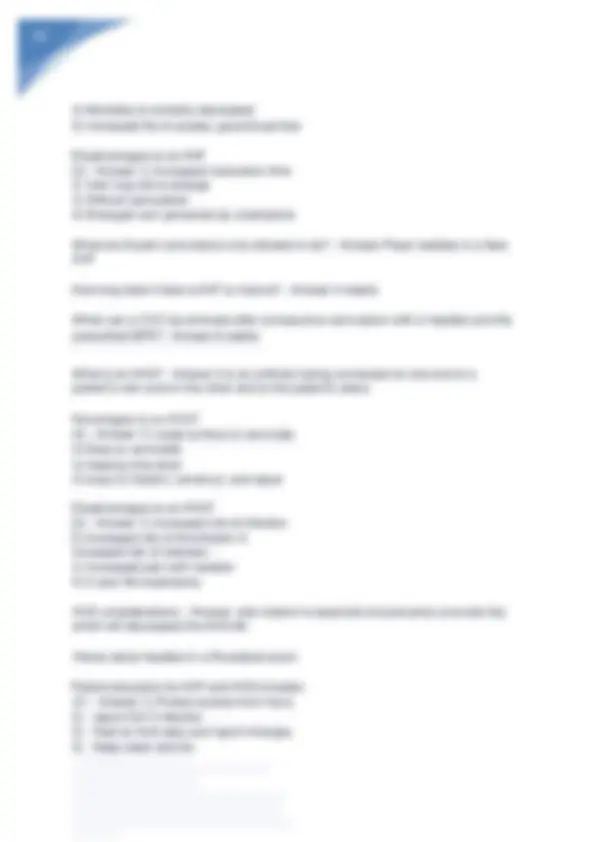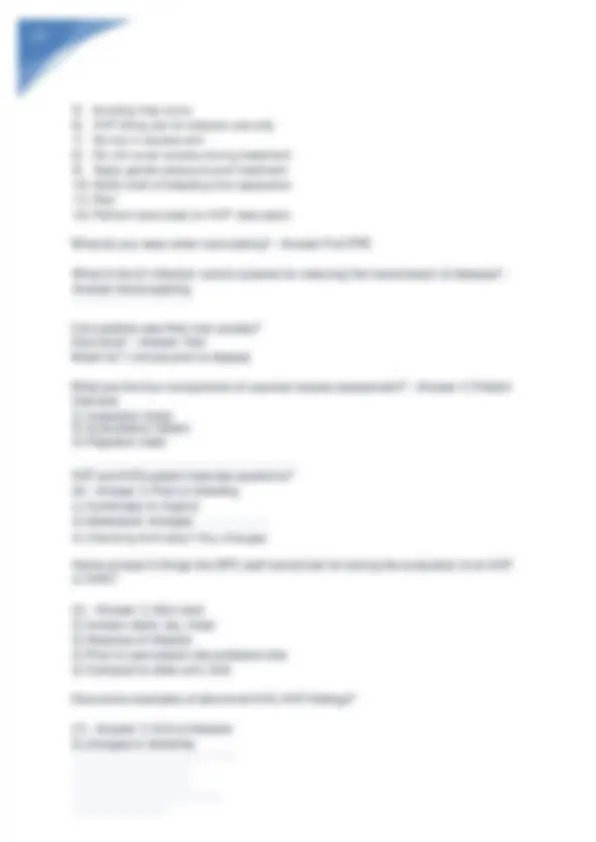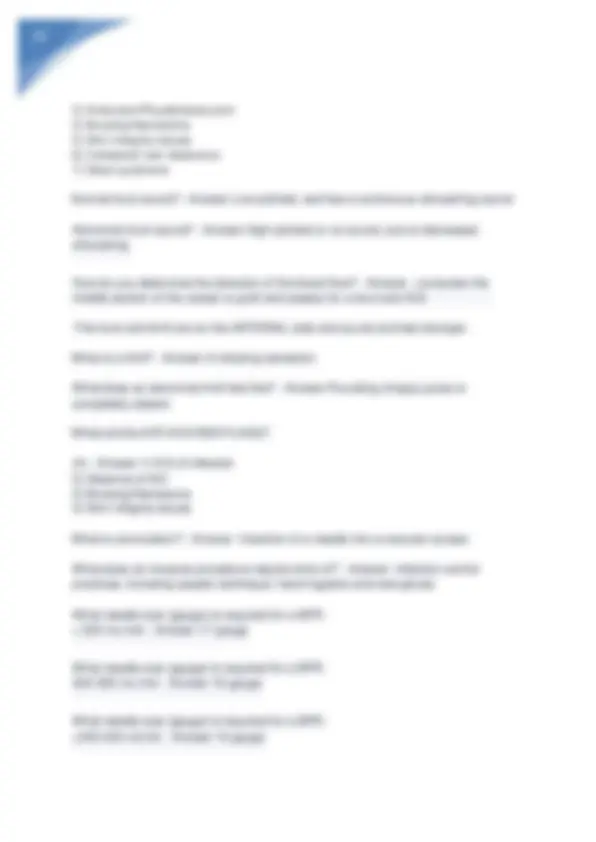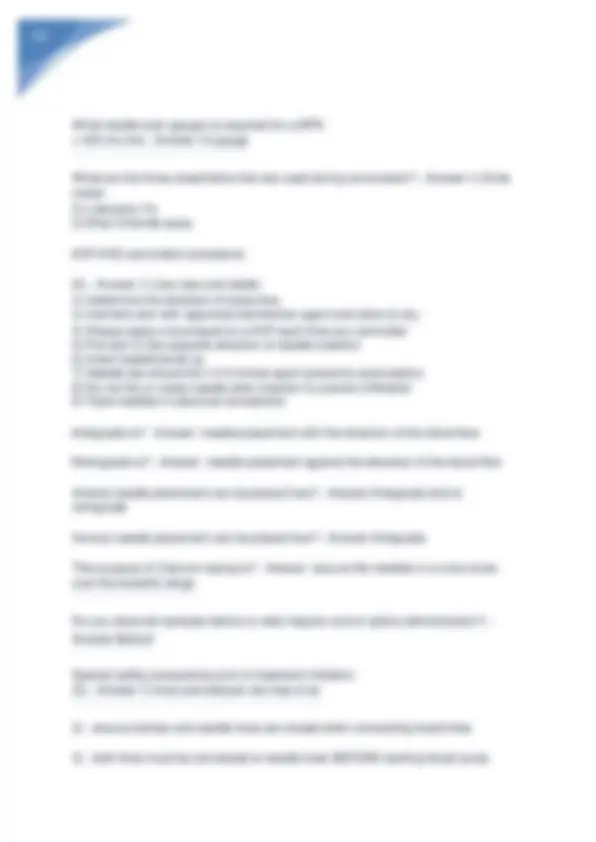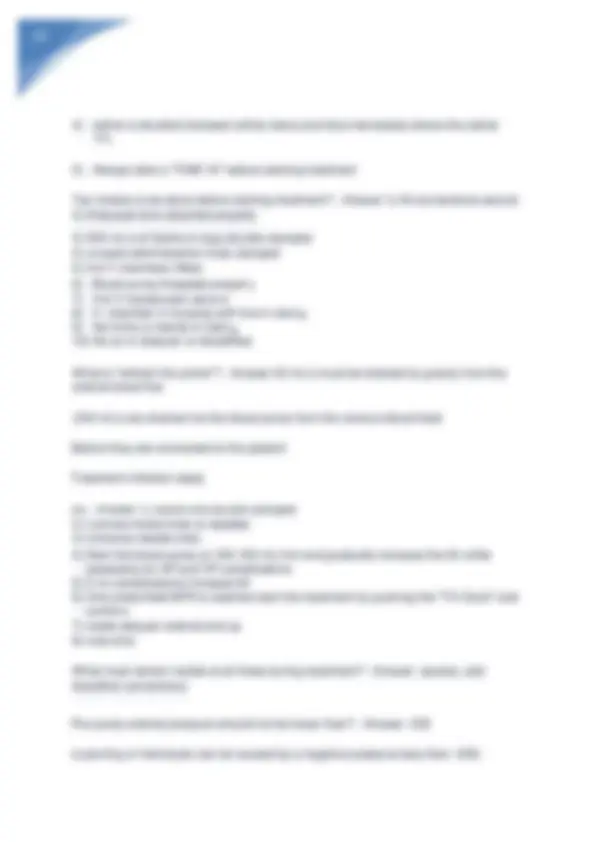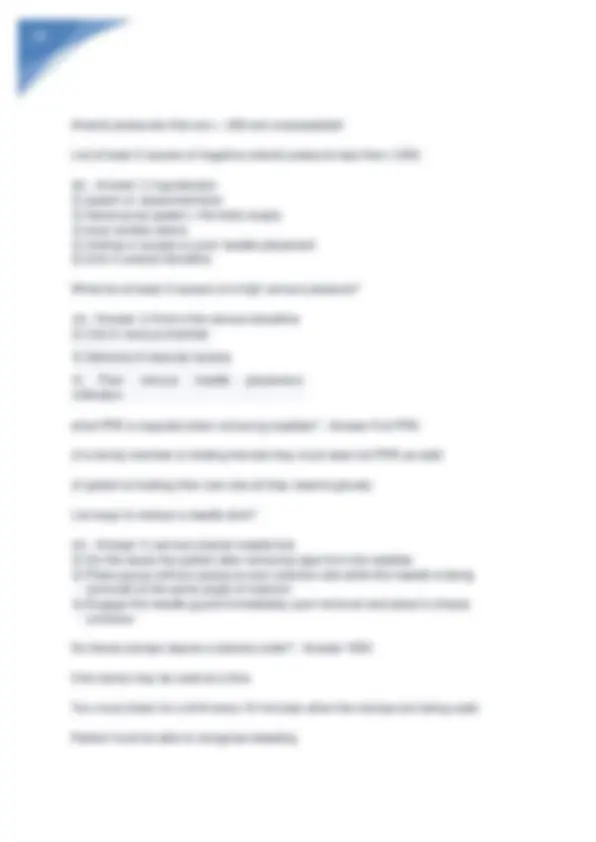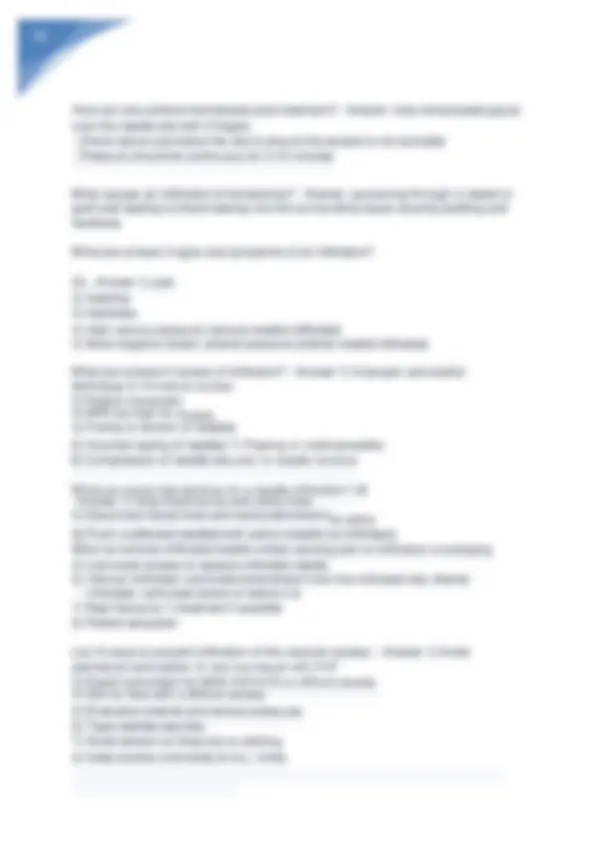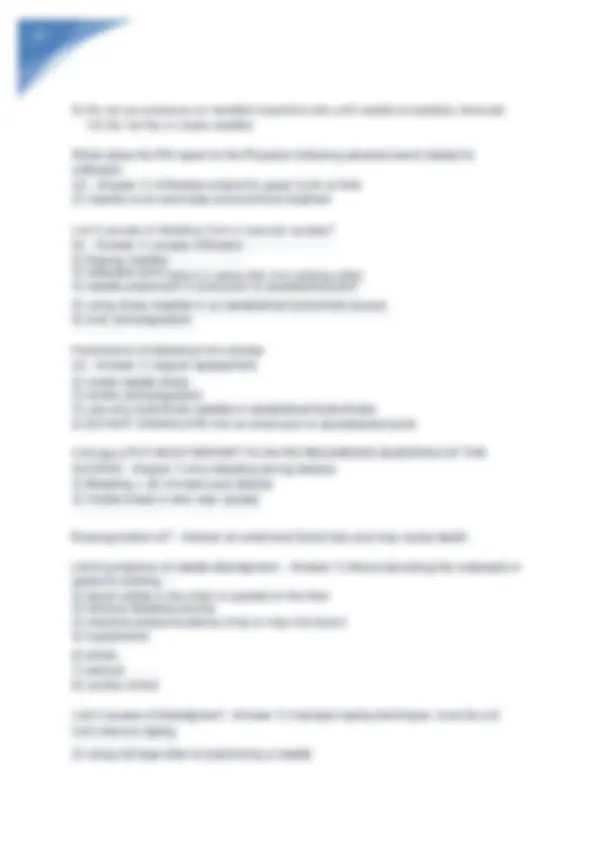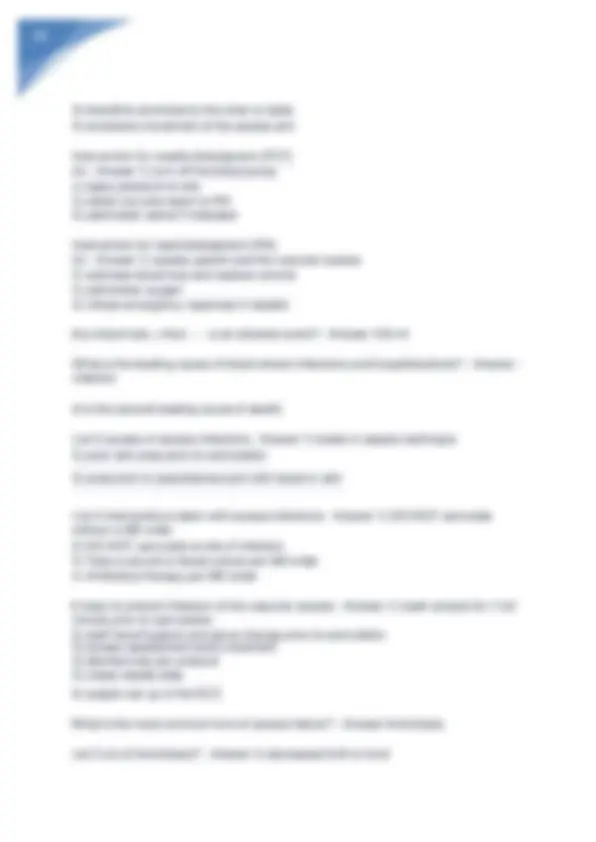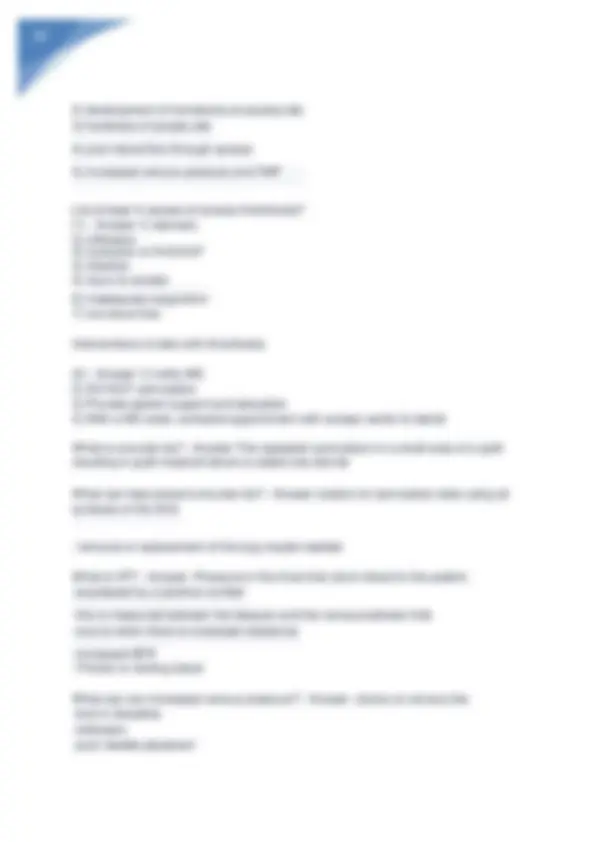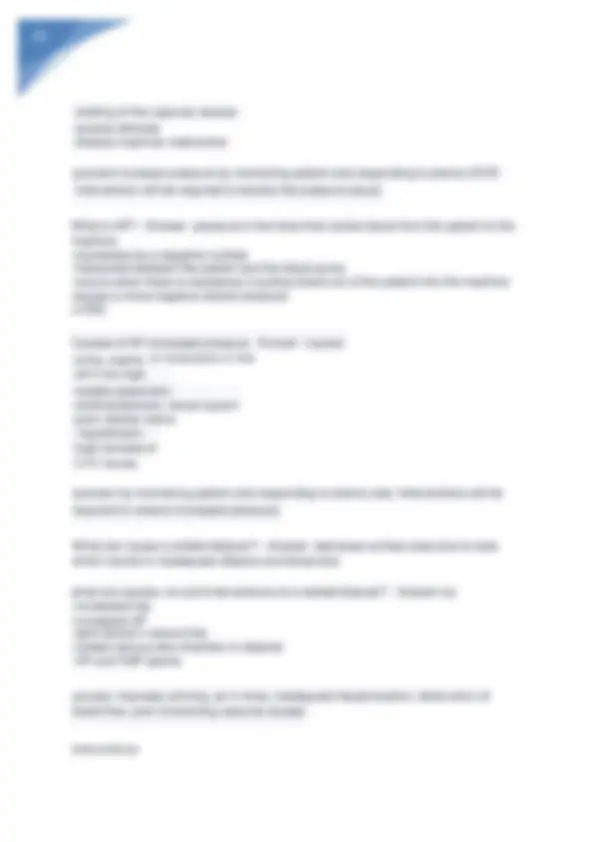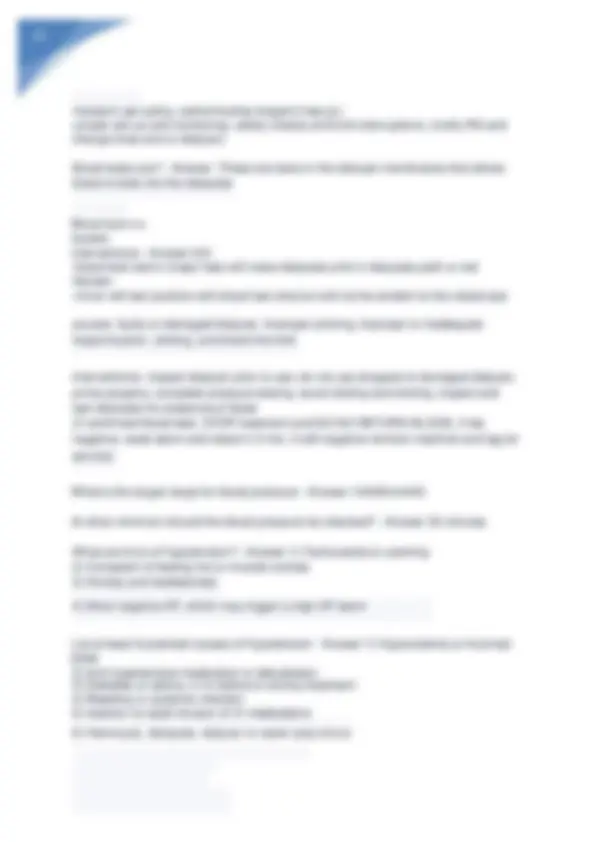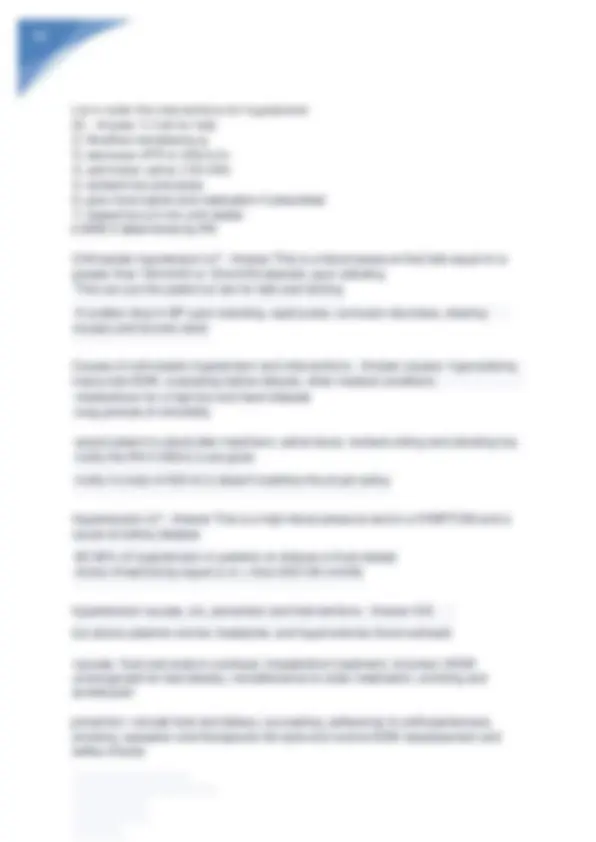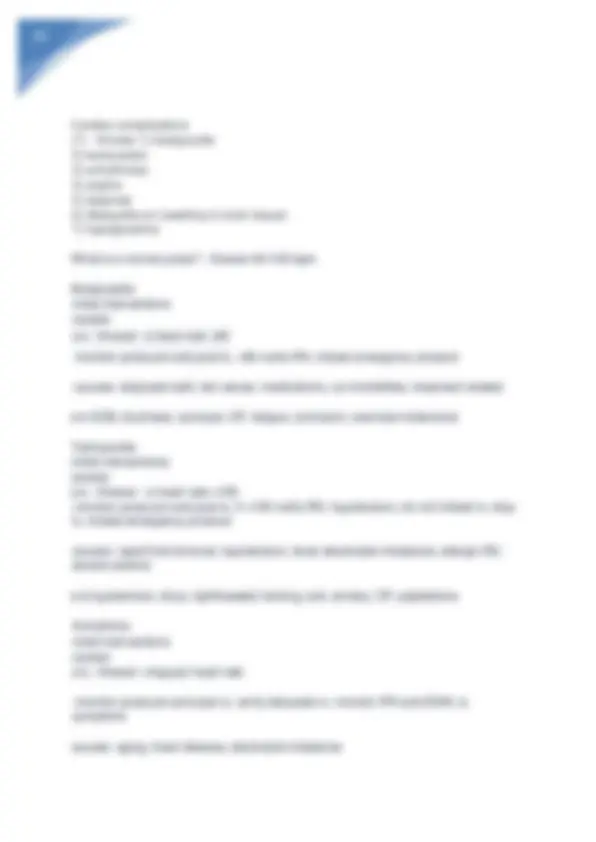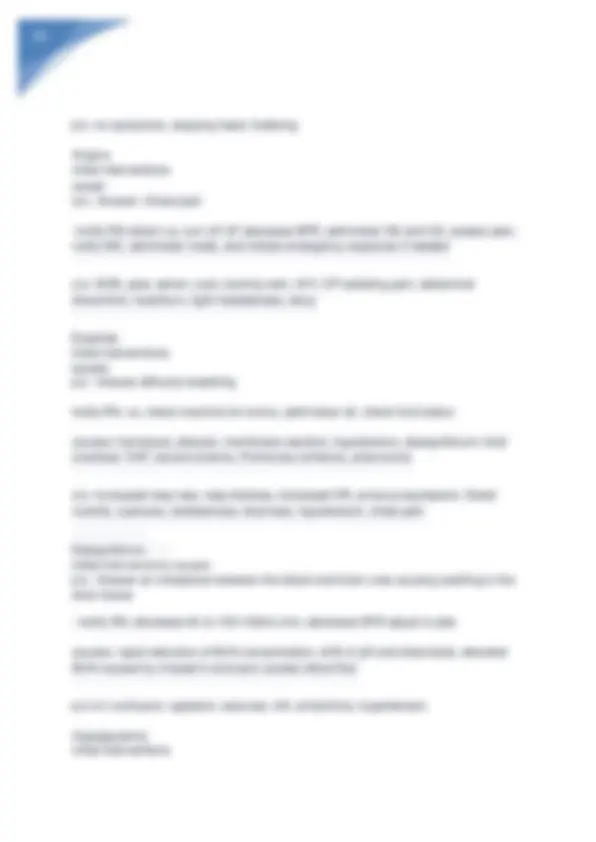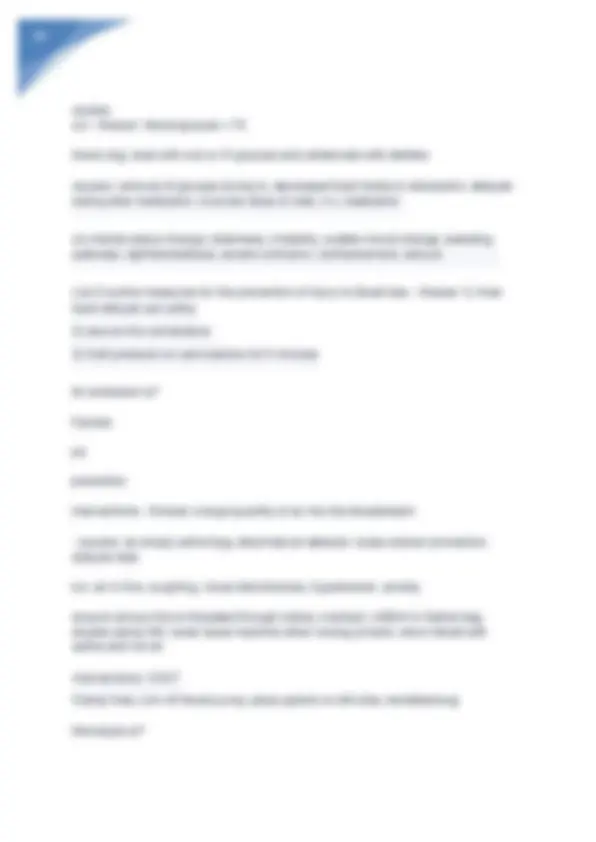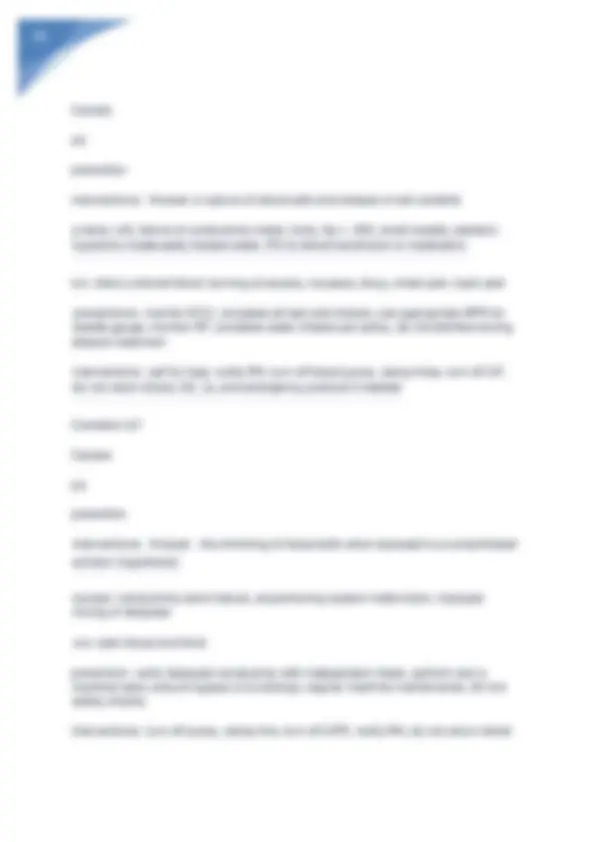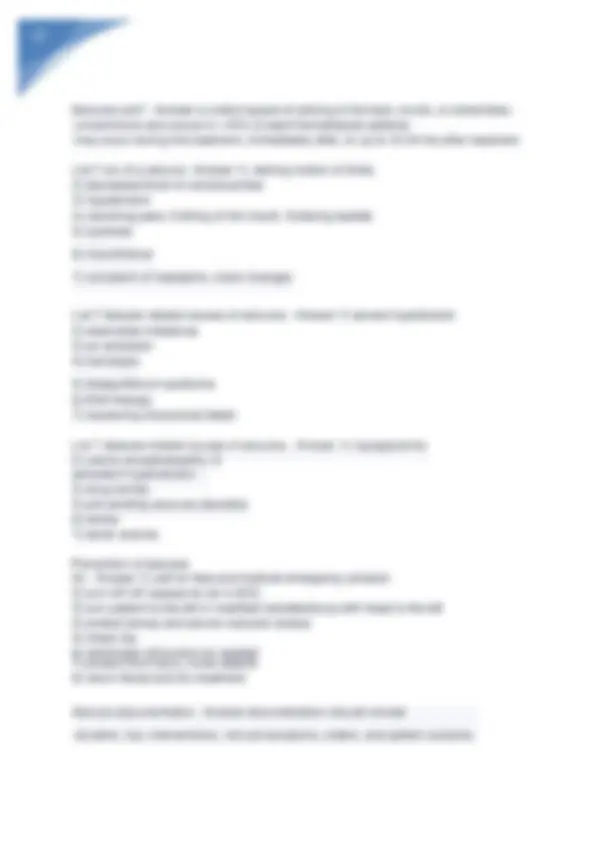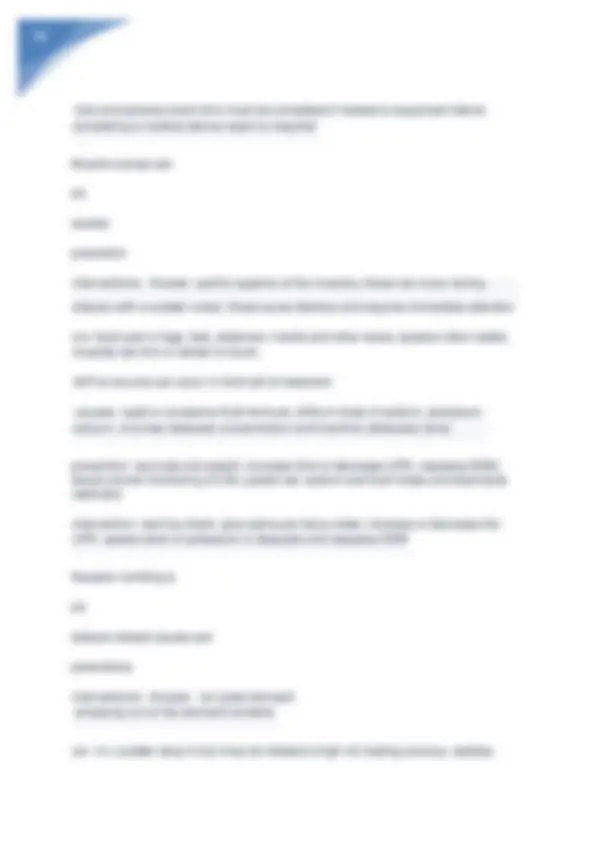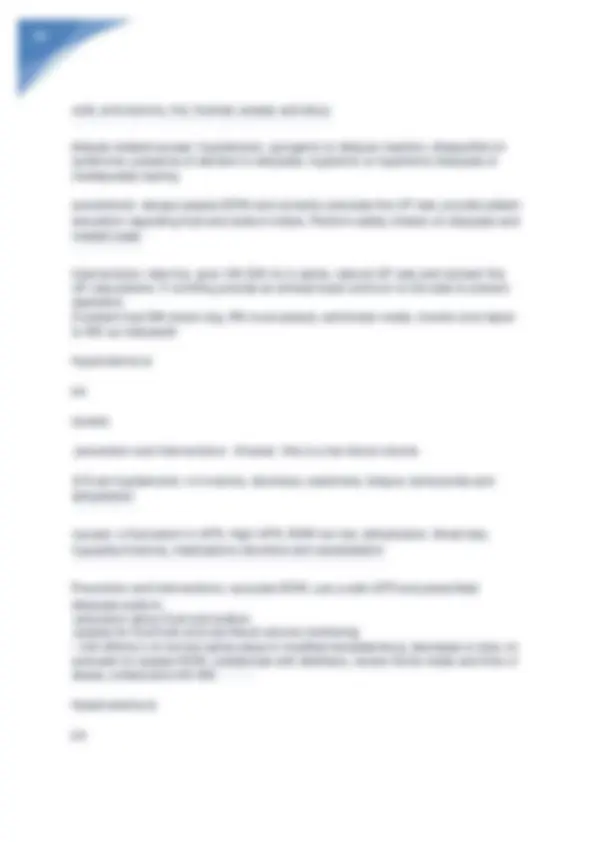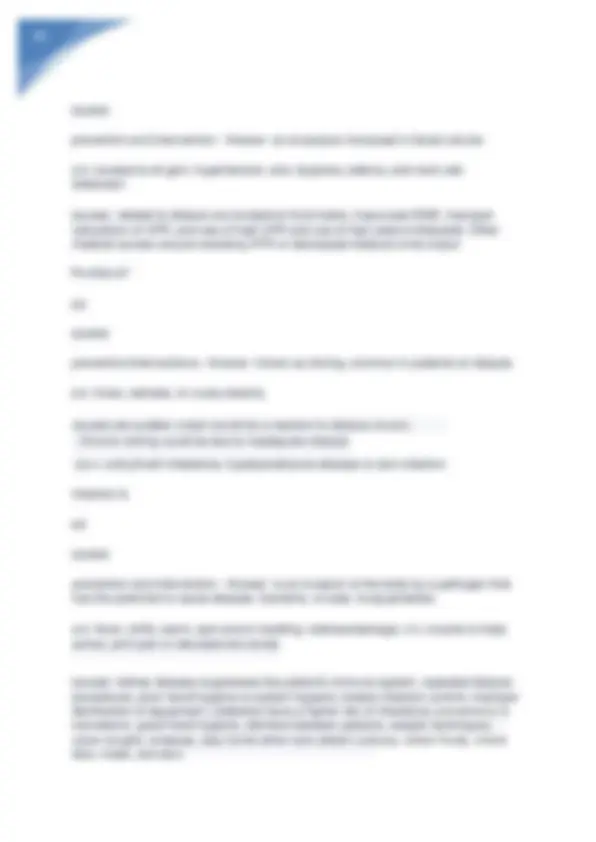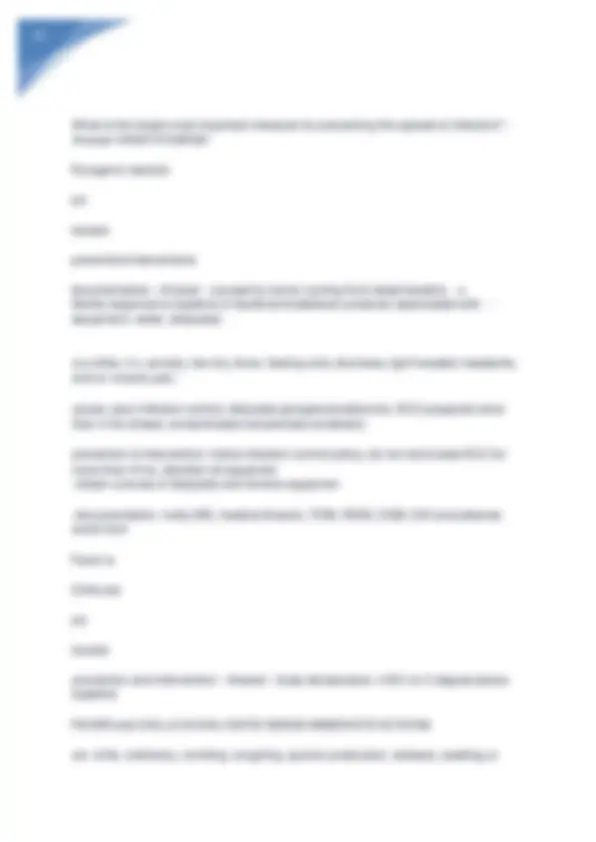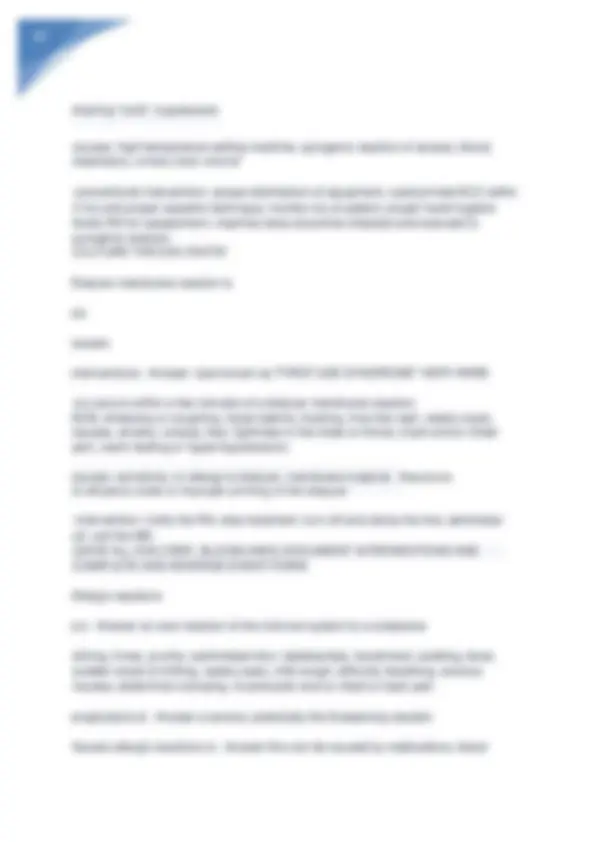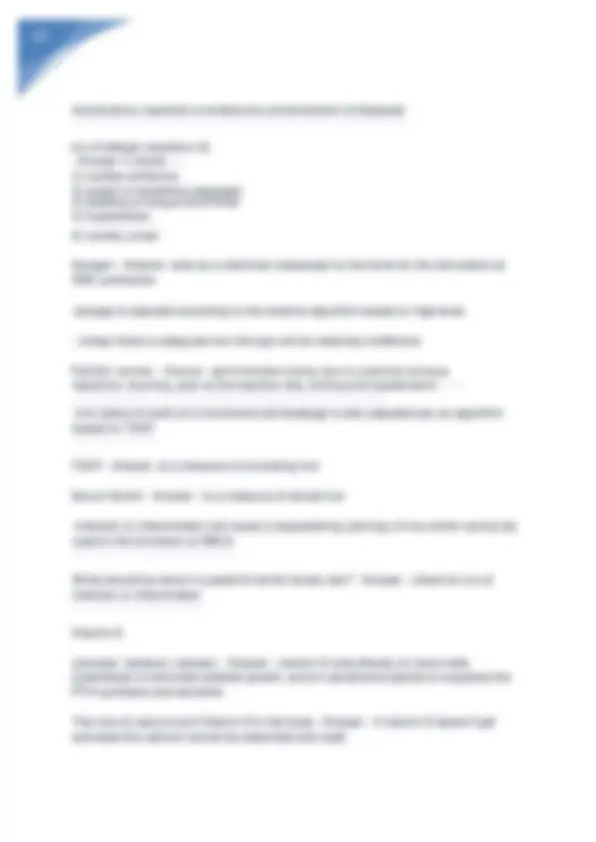Download FRESENIUS PCT EXAM 2023-2024 ACTUAL EXAM 200 QUESTIONS AND CORRECT ANSWERS|ALREADY GRADED and more Exams Nursing in PDF only on Docsity!
FRESENIUS PCT
EXAM 2023 - 2024
ACTUAL EXAM 200
QUESTIONS AND
CORRECT
ANSWERS|ALREADY
GRADED A+
FRESENIUS EXAM ALREADY GRADED
A+ 2023
What is a pre-dialysis evaluation? - Answer 1) Review of the patient's health.
- Compares current health status to previous evaluations. Why is pre-dialysis evaluations needed? - Answer 1) To determine if the patient is stable to receive treatment
- Determine if there has been a change in health status.
- Provides a baseline date to plan for a safe treatment. Describe Universal precautions - Answer Steps we take with all patient contact to decrease the risk of spreading infection to protect our patient and ourselves What are the 3 C's? - Answer 1) Condition (objective)
- Complaints (subjective)
- Changes (objective) What should you look for with Ambulation - Answer Gait changes, use of assistive devices, ROM, energy level. What should you look for with Mental status and mood - Answer A&O x 3, any changes in usual mood (Alert and orientation) Person, place, time (situation) A&Ox What should you look for with Skin - Answer Color, integrity, temperature, edema What should you look for with Vital signs - Answer Weight, BP, HR, respiration's, temperature What is EDW? Estimated Dry weight - Answer A patient's wt with excess fluid removed When is a RN required to assess a pre-treatment wt? - Answer If the patient pre- treatment wt is >4 kg above EDW What does a blood pressure measure? - Answer Measurement of the pressure of
- special attention order
- prescribed dialysa
- prescribed bicarbonate Cardiac - Answer Skin color and turgor, heart sounds, pulse rate, rhythm & quality, edema, pain, SOB Why do patients expreience crackles (rales) breath sounds? - Answer Indicates fluid or congestion in lungs Name some reasons for an abnormal heart rate? - Answer Can indicate chemical imbalances or adverse effects from medications Names some places fluid can get trapped? (Edema) - Answer Abdomen, lungs, feet, legs, hands,and face What are the ranges for pitting edema? - Answer 1 - 4 cm What do you do when you have a red light as a complaint? - Answer Do not start the treatment until the RN has done a full assessment on the patient Dialysis Prescription and Pre-treatment safety checks: Name what verifies the correct patient's dialysis prescription? (11) - Answer 1) patient Identity
- prescribed dialyzer te s
- SVS or UF profiling
- prescribed heparin dose
- OLC volume/test entered
- prescribed dialysate rate
- prescribed base sodium
- prescribed needle size Name important information programmed into the machine. (6) - Answer 1) Prescribed treatment time
- UF goal entered correctly
- Prescribed BFR
- Prescribed DFR
- OLC volume
- Na modeling or UF profile Name the final dialysis machine safety checks. (5) - Answer 1) Dialysate temperature
- Dialysate pH & conductivity
- NS doubled clamped
- Alarm & pressure holding test passed
- Final check on blood circuit What is a priority and major reason why we monitor our patients? - Answer Patient safety As fluid shifts during dialysis what changes can occur? - Answer Blood pressure, fluid and electrolyte shifts Who is responsible for monitoring patients? - Answer Everyone!
- clotting in the acce ss or dialyzer
- poor CVC function Describe what the arterial pressure reading reflect? - Answer Refers to the pressure in the system from the patient;s vascular access to the blood pump What are the potential compliactions of a high arterial pressure? (2) - Answer Inadequate dialysis and hemolysis Name 5 reasons for a high arterial pressure? - Answer 1) A kink in the arterial line 2) Poor cardiac status
- Blood pump speed to much for vascular access
- High hematocrit / increase blood viscosity
- High BFR through a small needle gauge What can a low arterial pressure indicate? - Answer 1) A line separation
- Air
- A decrease blood pump speed
- A wet transducer Describe what the venous pressure reading reflects? - Answer The pressure in the circuit after the dialyzer and before it re-enter the patient Name 5 causes for low venous pressure? - Answer 1) Blood line separation
- Needle dislodgemen
- Decrease BFR
- Clotting before the monitoring site
- Wet transduce What can cause high venous pressure? (5) - Answer 1) occlusion in the lines between the monitoring site and venous needle, 2) poor position
- an infiltration of venous needle What is the most important function of the dialysis treatment? - Answer Fluid removal How can fluid removal be monitored? - Answer Critline monitor or CLM Describe the 3 profiles that the CLM provides? - Answer 1) Profile A
- Profile B
- Profile C What does profile A look like? - Answer Profile shows a flat or a positive slope
- Heparin is infusing at the prescribed rate
- Transducer are dry and unclampe
- All connections are correct & secure
- An increase in the UFR may be appropriate What does profile B look like? - Answer Profile shows a gradual slope indicating the best compromised between a high UFR and prevention of symptoms during treatment What does profile C look like? - Answer Profile-shows a steep slope indicating a rapid decrease in blood volume and the patient is more likely to experience complications and intervention is required What does KT/V mean - Answer K= Clearance T= Time V= Volume What is the goal that FMC uses to calculate adequacy by KT/V - Answer 1. Describe the AMP lights meaning? Red - Answer The machine is in alarm mode Describe the Amp light meaning? Yellow - Answer means take action, the treatment will not meet our goal of 1.4 spKt/V Describe the Amp light meaning? Green - Answer means the patient will meet our goal of 1.4 spKt/V or above 4 )Lines secure in machine guides 5 )venous line in venous clamp
- Chambers are filled adequately
- NS is double clamped and contains at least 300 ml's
- Hansen's are correctly connected to the dialyzer d 30 minute checks include - Answer 1) vital signs
- vascular access
- machine checks (if the patient becomes unstable this must be done evey 5 minutes until the patient indicating UF and plasma refilling were equivalent during treatment Monitoring the ECC includes (10) - Answer 1) The entire circuit is visible
- Lines allow the patient position to change
- needle size 7 anticoagulation
- dialysate composition
- dialysate flow rate
- blood flow rate Identify five factors that affect dialyzer clearance? - Answer 1) BFR What are the goals of hemodialysis? (3) - Answer 1) removal of waste products
- regulation of fluid balance
- correction of electrolyte and acid/base imbalance Identify seven components of the hemodialysis prescription - Answer 1) treatment time
- type of dialyzer Identify four components of the extra-corporeal circuit. - Answer 1) Arterial line
- Venous line
- Needles
- Dialyzer Biocompatibility is? - Answer a term to describe a dialyzer membrane that is more like the human body and less likey to cause an immune response Dialyzers with more surface area allows? - Answer More removal of solutes. Transmembranes pressure affects? - Answer Fluid removal Pressure on the blood side is positive Pressure on the dialysate side is negative Define countercurrent flow? - Answer Blood flows one way while the dialysate flows the opposite wasy What is the advantages of countecurrent? - Answer Allows more net diffusion. Dialyzer clearance is the amount of what? - Answer Blood cleared of a given solute in one minute at agiven BFR and DFR
- chloride
- magnesium
2) DFR
- Dialyzer characteristics
- Treatment time and frequency
- Anticoagulation Dialysate is composed of - Answer 1) Treated water
- acidified concentrate (acid)
- bicarbonate concentrate Is dialysate clean or sterile - Answer Clean identify five electrolytes in the acid concentrate? - Answer 1) sodium
- potassium
- calcium Kidney failure causes what to build up and leads to what? - Answer 1) acid
- metabolic acidosis What componet of the dialysate treats metabolic acidosis? - Answer bicarbonate Identify the two sources of the bicarbonate in final dialysate? - Answer 1) bicarbonate concentrate
- Acetate in the acide concentration Two electrolytes that are part of the doctor's dialysate and are highlighted on the acid concentrate label are? - Answer Potassium and calicum Alarms to monitor the dialysate to ensure it is safe to use: - Answer 1) conductivity alarm
- temperature alarm What is conductivity? - Answer a measure of the ability of a solution to conduct an electrical charge Is verification of the conducitivy and pH required? - Answer Yes, before initiating treatment using a independent meter What verifies the conductivity and and pH?
- Access flow
- Frequency of alarms/tx
- Clotting
4) DFR
What is adequacy a measurement of? - Answer a measurement of how the dialysis is working to clear waste products from the patient's blood Inadequate hemodialysis results in: (3) - Answer 1) decreased sense of well being
- increased hospitalizations Two adequacy measurements are - Answer 1) URR (urea reduction ratio)
- Kt/V This is used to calculate Urea Kinetic Modeling? - Answer Kt/V What lab is used to measure adequacy? - Answer Pre and Post Bun Four causes of inadequate dialysis? - Answer 1) clotted dialyzer
- lower than prescribed BFR
- Shorter than prescribed treatment time
- significant recirulation Urea is present in all three body fluid spaces, name these fluid spaces? - Answer 1) Intracellular
- Interstitial
- Intravascular During hemodialysis urea is removed from only one body fluid space which is the? - Answer Intravascular space What is a OLC test? - Answer an estimate of the removal or clearance of urea from a single space of body fluid which is in the intravascular space What factors affect clearance? (7) - Answer 1) BFR 2) Treatment Time
- Dialyzer size During an OLC a diffusion of what is used as a marker for urea? - Answer Sodium
- increased risk of death
- Used hand hygiene before putting on gloves
- Gloves are considered "dirty" once applied (4) - Answer 1) Use aseptic technique when handling supplies The results of each OLC test is represented by the - Answer KECN number goal is > What is the meaning of KECN - Answer Clearance effective by Conductivity How is an OLC volume calculated for a new patient? - Answer New patient's EDW x 55% What does a trending down KECN mean, without changes in the bfr or dfr? - Answer A decreasing surface area due to clotting No amp light at the time of treatment start indicates? - Answer Volume not entered Amp lights are a visual cue for? - Answer Adequacy Green= spkK/v >1. Yellow= spKt/v <1.4 (intervention required) Red= machine is alarming What PPE (personal protective equipment) is required when setting up a dialysis machine? - Answer 1) Gloves
- Gown
- Face sield or mask with googles What are some important infection control reminders when setting up the dialysis machine?
- Wear full PPE for initiating or terminating treatment or exposure to blood, body fluids or chemicals Explain the dialysate delivery system? - Answer a proportioning unit (inside the machine) mixes RO water with two dialysate concentrates (acid and bicarb) to form dialysate. The machine monitors the "bath" to ensure patient safety and allow staff to monitor dialysate parameters during treatment. The dialysate flows into the dialyzer allowing osmosis and diffusion to occur, the
- Caps are intact
- No visible defects
- Packaging intact to a GFCI out
- Ftr safety reasons, it is imperative the dialysis machine power cord is plugged in let
- Heater and Power switches on the back of the machine are turned "on"
- Acid and bicarb lines are secured into machine ports
- Verify date of last disinfection
- Dialyzer supply lines and diaylzer return line are connected to the machine shunt
- Emergency hand crank availa When inspecting the dialyzer what are you looking for? (5) - Answer 1) Type and Size ordered
- Expiration date How is the correct dialysate prescription entered into the dialysis machine? - Answer
- concentrate icon 2251 - 0 ,2 K, 2.5 Ca++ and 100 dextros
- enter formula for the prescribed concentrate
- Verifiy the potassium and Ca++ match the order Enter base sodium and Bicarb levels Explain theoretical conductivity (TCD)? - Answer a setting in the dialysis machine for each dialysate concentrate. To ensure delivery of safe dialysate, the conductivity default alarm limits. This must be maintained at +/- 0.5S/cm of the TCD What is the temperature icon on the machine represents? - Answer The dialysate temperate is part of the Doctor's orders The typical range is 35.5- 37 When are the safety check completed? - Answer Theses are required before starting each patient treatment What are the pre-treatment safety checks? - Answer Alarm and Pressure test How do you know if the test passed or failed? - Answer Alarm screen will indicate if the pressure test failed with an audible and visual alarm A red "X" will appear next to the test that has failed What are the required step to turn on the dialysis machine on in the morning? (9) - Answer 1) Water supply line is connected to machine
- Drain line inserted into drain receptacle behind the machine
What do you do if your machine fails a test? - Answer 1) Retest
- If the failure repeats, inform the nurse
- remove the machine from the treatment area
- Label to identify which test failed
- Notify Bio Med Explain pH testing? - Answer - pH measures the acidity or alkalinity of a solution
- Verify the dialysate pH using a Phoenix meter or pH strip
- pH range must be 609 - 7.
- If pH is out of range, re-calibrate the meter and retes
- If retest fails, remove machine from floor (report and tag
- Document pH results in chairside How is a second signature obtained? (Double) - Answer - A second person MUST witness the machine and meter testing for conductivity and pH
- Independent meter and machine conductivity must be between +/- 0.3 mS/cm Why is circulating important? - Answer - It helps to clear dialyzer and bloodline of any sterilants or residue.
- Removes any remaining air in lines.
- BFR should be 300 - 400m;/min and dialysate flow rate should be 500ml/min until air is purged from lines What should be done if the extracorporeal circuit is up for 2 hours? - Answer Dialyzer primed for more than 2 hours must be recirculated using an increased ultrafiltration rate 5 minutes before use At what time should primed lines be discarded? - Answer If the lines have not been used within 4 hours What must be done with a machine that is not working properly? - Answer - Do not use a machine that is out of range or failed an Alarm/Pressure test
- Machine should be removed from treatment floor and "yellow tag" should be completed.
- Biomed notified How is the arterial bloodline returned? - Answer - Make sure saline bag has at least 300 ml's
- reduce the BFR to minimum and stop
What must be done to any supplies taken to a dialysis station? - Answer - Discard any disposable supplies remaining
- Disinfect reusable items
- If patient has "designated items" clean and place in named box How are clamps cleaned? - Answer Clamps are opened and placed in 1:100 bleach solution (Container must be opaque and covered with a lid) What is "acid cleaning"? - Answer This is done after EVERY TREATMENT to prevent buildup of bicarbonate precipitate What is heating disinfecting? - Answer - Heat used to disinfect internal pathways using water heated to ~ 80 C
- Performed after Acid Clean or Bleach disinfected is completed Explained bleach disinfect/Diasafe testing? - Answer _Disinfect internal pathways using bleach
- Done at least weekly What are two types of internal vascular access? - Answer Arteriovenous graft Arteriovenous fistula What is the preferred access type of vascular access? - Answer Arteriovenous Fistula What is an AV Fistula? - Answer An access is the the patients own artery connected to the vein
- AVF the first choice is the wrist/radiocephalic (they preserve the proximal vessell and have fewer complications.) Advantages to an AVF (5) - Answer 1) Decrease thrombosis
- Less infection
- Cost lower
- 2 year life expectancy
- Easy to implant, construct, and repair
- Morbidity & mortality decreased
- Increased life of access, good blood flow Disadvantages to an AVF (4) - Answer 1) Increased maturation time
- Vein may fail to enlarge
- Difficult cannulation
- Enlarged vein perceived as unattractive What are Expert cannulators only allowed to do? - Answer Place needles in a New AVF How long does it take a AVF to mature? - Answer 4 weeks When can a CVC be removed after consecutive cannulation with 2 needles and the prescribed BFR? - Answer 6 weeks What is an AVG? - Answer It is an artificial tubing connected on one end to a patient's vein and on the other end to the patient's artery Disadvantages to an AVG? (5) - Answer 1) Increased risk of infection
- Increased risk of thrombosis 3) Increased risk of stenosis
- Increased pain with creation AVG considerations: - Answer - site rotation is essential and prevents (one-site-itis) which will decreased the AVG life
- Never place needles in a Psuedoanurysm. Advantages to an AVG? (4) - Answer 1) Large surface to cannulate
- Easy to cannulate
- Healing time short Patient education for AVF and AVG includes 12: - Answer 1) Protect access from injury
- report S/S if infection
- Feel for thrill daily and report changes
- Keep clean and dry

